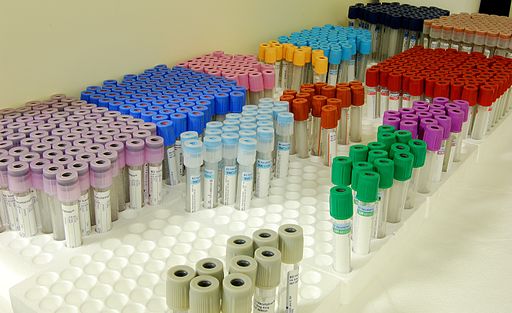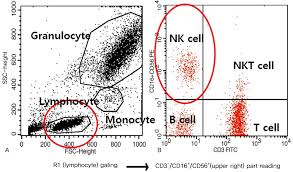Blood, Anemia, Leukemia, and Blood Tests
Blood Tests
Emily Frawley
Learning Objectives
By the end of this section, you will be able to:
- Describe the general process of blood collection, labeling, and transportation to the laboratory.
- List possible reasons for blood sample rejection, and explain the implications of sample rejection for patient care.
- Compare and contrast the core functions of key laboratory departments (Chemistry, Hematology, Microbiology, and Transfusion medicine), and explain the types of tests and biological samples each department typically handles.
At some point in one’s life, blood testing will become necessary – whether at a health care provider’s office, lab testing facility in the community, or while in a hospital. But how a tiny 5 ml vial of blood tell so much about one’s state of health?
Ordering and Collection of Blood for Testing
Clinical laboratories process, test, and obtain results from hundreds to tens of thousands of samples a day, depending on the size of the lab.
When samples arrive in the laboratory, they must be received into the lab’s Laboratory Information System (LIS). A staff person, usually a Medical Laboratory Assistant (MLA), will confirm the patient’s identification. They will also ensure that all samples and requisitions contain at least two unique identifiers and check that the ordering requisition’s information matches with the sample unequivocally. A bar-coded label may be applied at this time or it may have already been applied by the phlebotomist that drew the sample. The received samples are then checked to confirm the expected number and type of samples and for proper centrifugation and sample stability.
If there is an error in any of the previous steps, it may cause the sample to be rejected. It cannot be tested and the ordering physician will be notified so that the sample may be recollected. If a given clinical lab is does not run the test required by the physician, the sample will be “sent out” to another location or reference laboratory that does perform the test.
Scanning the barcode into the LIS alerts the laboratory that the sample is available in the laboratory and ready to be tested. The Chemistry department typically uses gold-topped SST tubes while the Hematology department uses lavender-topped EDTA tubes. Microbiology and Molecular samples are usually more varied and include things such as throat swabs, urine, stool, human tissue, and other sterile body fluids.
Blood Chemistry (Serum/Plasma/Urine)
The Chemistry department primarily uses serum or urine as the sample type for testing. Serum is the clear, pale yellow liquid component of blood that remains after the blood cells and clotting factors have been removed. It makes up about 55% of the total blood volume. Plasma can also be used for some chemistry tests.
While Medical Laboratory Technologists (MLTs) in the department often test samples for electrolytes such as sodium and potassium, many other tests can be run on serum samples. These may include tests for cardiac markers, pregnancy and reproductive hormones, cancer markers, drug screening, sexually transmitted infections, and liver or kidney hormones. Chemistry test methods include immunoassay to detect and quantify specific molecules, ion-selective electrodes analysis for electrolytes, and enzymatic reaction assays. More specialized Chemistry testing may be done to identify allergies and food sensitivities or to analyze the levels of certain harmful or therapeutic drugs.

Hematology (Complete Blood Count)
The Hematology department is responsible for analyzing whole blood samples. These tests use un-centrifuged blood to diagnose and monitor medical conditions relating to the function of a patient’s red cells, white cells, and platelets. One of the most commonly requested tests is the complete blood count (CBC) test, generally run by MLTs on an automated hematology analyzer. The size, complexity, and number of a patient’s cells are measured to provide important information about a patient’s health.

The size and shape of red blood cells can help diagnose different types of anemia, while white blood cell differentiation is crucial in identifying blood cancers and current infections in the body. Platelets are also measured to determine a patient’s risk for bleeding or clotting disorders. Samples with abnormal parameters are further analyzed by an MLT looking directly at a stained blood smear on a slide to help identify and characterize abnormal cells. That slide may be sent on to a pathologist for further interpretation before a final result is determined. The Hematology department is also responsible for testing samples for clotting disorders.
Microbiology
The Microbiology Department tests a wide variety of bodily substances for bacterial, viral, parasitic, or fungal infections. Samples from patients with suspected pneumonia, sepsis, food poisoning, and urinary tract infections get spread onto an agar gel infused with nutrients or placed in a nutrient broth. These plates or tubes are then incubated aerobically or anaerobically at the suspected organism’s optimal growth temperature.
Once the organism has grown to a detectable level, MLTs isolate it and determine if it’s normal flora or a pathogen. Biochemical analysis and an algorithmic system of confirmation testing is used to identify isolated pathogenic bacteria. Molecular testing and immunological methods can be used for the rapid diagnosis of common pathogens by identifying specific molecules unique to a given organism. The Microbiology Department also identifies bacteria with antibiotic resistance and can recommend the most effect antibiotic or antibiotic combination for that bacteria.
Medical Laboratory Sciences (Microbiology) and Pneumonia created by Marion Regan & Jennifer Kong, licensed under a CC-BY-NC
Transfusion Medicine
Transfusion Medicine or Blood Banking is another department within the Medical Laboratory Sciences but it is generally a self-contained unit typically located within a hospital. This department plays a critical role in ensuring the safe and effective use of blood products for transfusion. Blood samples are kept onsite for analysis or sent to a group such as Canadian Blood Services for testing and storage.
Patient samples must be carefully matched with donor units to prevent rejection by the body’s immune system. The Transfusion Medicine Department will also maintain and issue plasma, platelets, and other products to enhance or enable clotting in deficient patients, RhoGAM to prevent hemolytic disease of the newborn (HDN) during pregnancy, and some intravenous immunoglobulins (IVIg).
Storage of Blood Samples for Future Tests or Disposal
Once the sample has undergone all the necessary tests, the samples are stored in a refrigerator or freezer. They may be kept for 3 to 7 days, depending on the laboratory’s storage protocols. This allows healthcare providers the opportunity to add-on or follow-up on any previously ordered tests. It not only reduces the need for additional blood draws from the patient but also allows for a more comprehensive evaluation of the patient’s condition. If no additional testing or follow-up is required, the tubes are disposed of into biohazardous containers, which are then transported to a waste facility for proper incineration.
Section Review
Blood tests are an essential part of health care. Health care providers can order tests, performed by medical lab technologists, to examine for components in blood (both blood cells and plasma), urine, sputum, and more!
A blood test involves blood being taken from a patient and the blood separated into either the plasma (for chemistry analysis) or blood cells (Hematology). These tests often determine the health of a patients organs or blood based on the presence (or absence) of components in the plasma and/or changes in blood cell number or shape.
Infections can occur in patients which require identification of the organism to prescribe antimicrobial treatment. Microbiology tests of bodily fluids (e.g. urine, saliva, discharge from an infection) are performed to first identify the microbe and then determine which antimicrobial agent/treatment is appropriate.
Transfusion science is a separate branch of medical laboratory sciences, focusing on the banking and storage of blood and blood products. They ensure the quality and safety of the blood and blood products, prior to distribution to patients in need.
When the blood test result is sent to the health care practitioner, the remaining blood samples are refrigerated and kept for days up to a week to allow for re-testing, if requested.
Review Questions
Media Attributions
- 512px-Drawing_Test_tubes_different_colors © Goldmund 100 is licensed under a CC BY-SA (Attribution ShareAlike) license
- Flow_Cytometry © CharlotteHayden is licensed under a CC BY-SA (Attribution ShareAlike) license

